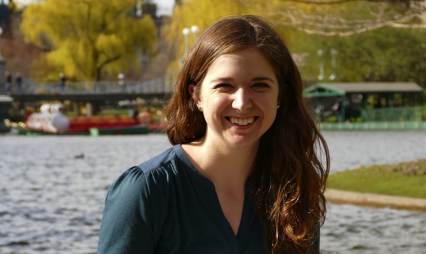Creative Minds: Teaming Math and Science for an HIV Cure
You may have heard about young mathematicians who’ve helped to design cooler cars, smarter phones, and even more successful sports teams. But do you know about the young mathematician who is helping to find a cure for the estimated 35 million people worldwide infected with the human immunodeficiency virus (HIV)? If not, I’d like to introduce you to Alison Hill, a mathematical biologist at Harvard University, Cambridge, MA.
Recognized this year by Forbes Magazine’s 30 Under 30 as one of the most important young innovators in healthcare, Hill is teaming with clinicians to develop sophisticated mathematical tools to predict which experimental drugs might work to clear HIV from the body once and for all. While current treatments are able to reduce some patients’ HIV burden to very low or even undetectable levels, it is eradication of this viral reservoir that stands between such people living with a serious, but controllable chronic disease and actually being cured.
The combination therapies used today are effective at killing HIV when it is replicating, but they don’t kill HIV that has integrated into the genome of a human immune cell. This latent HIV has the potential to reactivate and begin replicating, unleashing HIV’s potentially deadly immunosuppressive effects. This means HIV-infected people currently must stay on antiretroviral drugs for their entire lives, which can be costly and poses a risk of developing drug-related side effects including kidney, cardiovascular, and neurological problems.
In recent years, researchers have proposed targeting dormant HIV with new types of drugs called latency-reversing agents. These chemical compounds are designed to take aim at latent HIV and coax it into replicating. Once that occurs, combination therapy can be used to kill the activated virus, ultimately eliminating the reservoir of HIV.
That’s where Hill enters the picture. In the absence of good clinical data to model latent HIV and predict its interactions with different compounds, this NIH Director’s Early Independence awardee develops and applies mathematical tools to predict which compounds have the best shot at working, as well as to inform the design of clinical trials.
Hill’s mathematical models also can be used to explore other profoundly important questions about HIV care. For example, she has already studied how much of the latent virus reservoir must be wiped out before patients can safely stop taking their medications. Hill’s simulations indicate that at least 99.99% of latent HIV must be destroyed to produce a significant reduction in the chance of a rebound infection once a patient stops drug therapy [1]. That’s certainly a sobering number—and one that is far beyond what can be achieved with the latency-reversing drugs now being tested.
Still, Hill’s work helps to establish a benchmark for what’s needed to truly eliminate HIV from the body. It also underscores why doctors recommend that people with HIV continue taking combination therapy after experiencing major declines in their viral burden—even to the point that HIV can’t be detected by current tests. In the meantime, it will be exciting to watch this young mathematician’s research unfold as she and so many other NIH-funded scientists strive to achieve an ambitious goal with potential to benefit millions of people around the globe: a cure for HIV.
Reference:
[1] Predicting the outcomes of treatment to eradicate the latent reservoir for HIV-1. Hill AL, Rosenbloom DI, Fu F, Nowak MA, Siliciano RF. Proc Natl Acad Sci U S A. 2014 Sep 16;111(37):13475-80.
Links:
HIV/AIDS (National Institute of Allergy and Infectious Diseases/NIH)
Hill NIH Project Information (NIH RePORTER)
NIH Support: Common Fund



































No hay comentarios:
Publicar un comentario